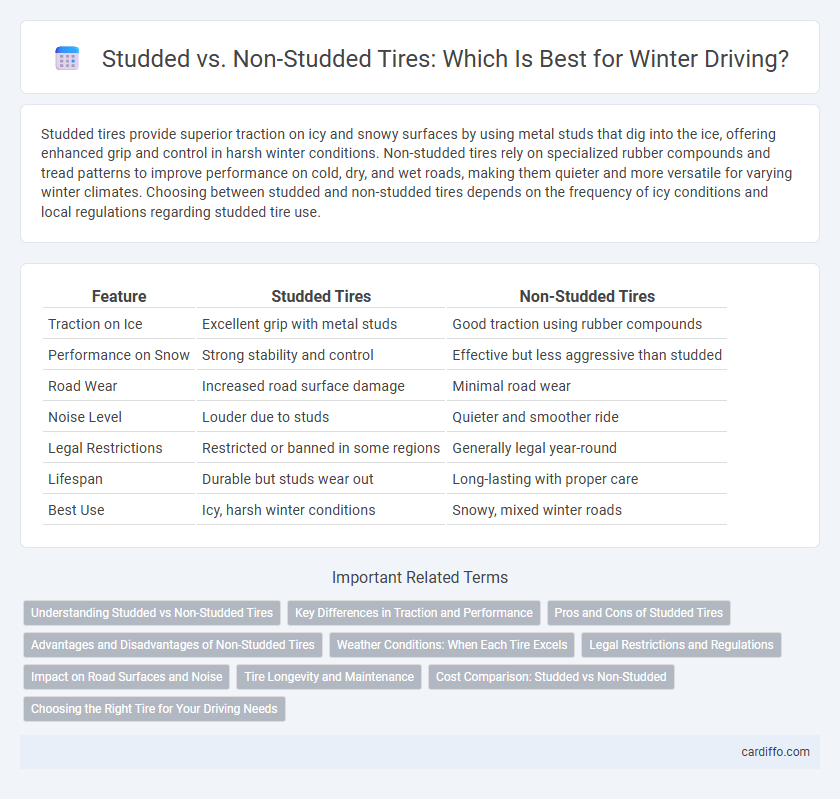Studded tires provide superior traction on icy and snowy surfaces by using metal studs that dig into the ice, offering enhanced grip and control in harsh winter conditions. Non-studded tires rely on specialized rubber compounds and tread patterns to improve performance on cold, dry, and wet roads, making them quieter and more versatile for varying winter climates. Choosing between studded and non-studded tires depends on the frequency of icy conditions and local regulations regarding studded tire use.
Table of Comparison
| Feature | Studded Tires | Non-Studded Tires |
|---|---|---|
| Traction on Ice | Excellent grip with metal studs | Good traction using rubber compounds |
| Performance on Snow | Strong stability and control | Effective but less aggressive than studded |
| Road Wear | Increased road surface damage | Minimal road wear |
| Noise Level | Louder due to studs | Quieter and smoother ride |
| Legal Restrictions | Restricted or banned in some regions | Generally legal year-round |
| Lifespan | Durable but studs wear out | Long-lasting with proper care |
| Best Use | Icy, harsh winter conditions | Snowy, mixed winter roads |
Understanding Studded vs Non-Studded Tires
Studded tires feature metal studs embedded in the tread that provide enhanced traction on icy and snowy roads, making them ideal for extreme winter conditions. Non-studded tires, also known as studless or winter tires, use specialized rubber compounds and tread patterns designed to maintain flexibility and grip on cold, wet, and snowy surfaces without damaging the pavement. Choosing between studded and non-studded tires depends on local regulations, road conditions, and whether the primary driving environment involves frequent ice or just cold, slushy roads.
Key Differences in Traction and Performance
Studded tires provide superior traction on icy roads by embedding metal studs that grip the ice, significantly reducing slip and improving braking performance. Non-studded tires rely on advanced rubber compounds and tread patterns designed to channel water and slush, offering better performance on wet or snowy pavement without damaging road surfaces. The choice between studded and non-studded tires impacts vehicle handling, fuel efficiency, and tire wear depending on regional weather conditions and driving habits.
Pros and Cons of Studded Tires
Studded tires provide superior traction on icy and hard-packed snowy roads, significantly improving vehicle stability and braking performance in extreme winter conditions. However, their aggressive metal studs can cause increased road wear and noise, and they may be restricted or prohibited in certain regions due to environmental regulations. Non-studded tires offer quieter, more versatile driving on dry roads but generally deliver less grip on ice compared to studded options.
Advantages and Disadvantages of Non-Studded Tires
Non-studded tires offer superior road grip on wet and dry pavement due to their advanced rubber compounds, reducing noise levels and minimizing road wear compared to studded tires. They provide enhanced fuel efficiency and a smoother driving experience but may underperform on icy or hard-packed snowy surfaces lacking the mechanical grip of studs. Non-studded tires are ideal for regions with moderate winter conditions and legal restrictions on studded tire use.
Weather Conditions: When Each Tire Excels
Studded tires excel in icy and hard-packed snow conditions by providing superior traction through metal studs that grip frozen surfaces, making them ideal for severe winter climates. Non-studded tires perform better on wet, slushy, or mixed winter roads by utilizing advanced rubber compounds and tread patterns to enhance flexibility and water evacuation, ensuring safer driving in milder winter conditions. Choosing between studded and non-studded tires depends on regional weather patterns, with studded tires suited for consistently icy environments and non-studded tires preferable in areas with fluctuating temperatures and occasional bare pavement.
Legal Restrictions and Regulations
Studded tires are subject to strict legal regulations in many regions due to their potential to damage road surfaces, with some areas imposing seasonal usage bans or complete prohibitions. Non-studded tires face fewer restrictions and are often preferred for all-season use, as they comply more easily with environmental and safety standards. Understanding local laws is essential to avoid fines and ensure tire compliance on public roads.
Impact on Road Surfaces and Noise
Studded tires provide superior traction on icy roads but cause significant damage to asphalt and concrete surfaces, accelerating wear and leading to increased road maintenance costs. Non-studded tires generate less noise during operation and have a reduced impact on pavement integrity while offering adequate grip on snow-covered roads. Choosing between studded and non-studded tires requires balancing road safety with infrastructure preservation and noise pollution concerns.
Tire Longevity and Maintenance
Studded tires generally experience faster tread wear due to metal studs causing increased abrasion, reducing overall tire longevity compared to non-studded tires. Non-studded tires maintain better tread life under regular driving conditions, requiring less frequent replacement and lower maintenance costs. Proper tire rotation and alignment extend both studded and non-studded tire lifespan, but non-studded tires typically demand less upkeep in dry and wet climates.
Cost Comparison: Studded vs Non-Studded
Studded tires generally cost 20-30% more than non-studded tires due to the added metal studs designed for enhanced traction on icy surfaces. Maintenance expenses for studded tires can be higher because they may cause faster road wear and require more frequent replacement. Non-studded tires often provide a longer lifespan and lower overall ownership costs, making them a cost-effective option for regions with milder winter conditions.
Choosing the Right Tire for Your Driving Needs
Studded tires provide superior traction on icy and snowy roads by using metal studs to grip slippery surfaces, ideal for frequent winter driving in harsh conditions. Non-studded tires use advanced rubber compounds and tread designs to offer reliable performance on wet and lightly snowy roads while reducing road noise and wear on clear pavement. Choosing the right tire depends on your typical winter weather, road conditions, and local regulations regarding studded tire use.
Studded vs Non-Studded Infographic

 cardiffo.com
cardiffo.com